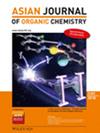Synthesis and Properties of Covalently Linked Terpyridine‐BODIPY and Terpyridine‐3‐Pyrrolyl BODIPY Conjugates
IF 2.8
4区 化学
Q1 CHEMISTRY, ORGANIC
引用次数: 0
Abstract
A series of covalently linked terpyridine‐BODIPY and terpyridine‐3‐pyrrolyl BODIPY conjugates were synthesized by strategically tuning the position of the terpyridine moiety at the α and/or meso positions of the BODIPY (3–4) and 3‐pyrrolyl BODIPY cores (5–7). These compounds were synthesized over a sequence of synthetic steps and their identities were confirmed by HR‐MS, 1D, 2D NMR, and X‐ray crystallography of one of the conjugates and studied by various spectroscopic, electrochemical, and theoretical techniques. The presence of terpyridine moieties on BODIPY and 3‐pyrrolyl BODIPY cores significantly alters their electronic properties and these conjugates absorb strongly in the 505–640 nm region. Furthermore, the α‐terpyridinyl 3‐pyrrolyl BODIPY conjugate was used as a ligand to form heteroleptic ruthenium(II/III) complexes. The Ru(II)/Ru(III) complexes exhibit weak fluorescence with significantly reduced quantum yield and single‐state lifetime due to the presence of a heavy Ru(II)/Ru(III) ion, which enhances spin‐orbit coupling and increases the rate of intersystem crossing (ISC), leading to non‐radiative relaxation. DFT and TD‐DFT studies corroborated our experimental findings, providing deeper insights into the structural, photophysical, and electronic properties of these conjugates.
求助全文
约1分钟内获得全文
求助全文
来源期刊

Asian Journal of Organic Chemistry
CHEMISTRY, ORGANIC-
CiteScore
4.70
自引率
3.70%
发文量
372
期刊介绍:
Organic chemistry is the fundamental science that stands at the heart of chemistry, biology, and materials science. Research in these areas is vigorous and truly international, with three major regions making almost equal contributions: America, Europe and Asia. Asia now has its own top international organic chemistry journal—the Asian Journal of Organic Chemistry (AsianJOC)
The AsianJOC is designed to be a top-ranked international research journal and publishes primary research as well as critical secondary information from authors across the world. The journal covers organic chemistry in its entirety. Authors and readers come from academia, the chemical industry, and government laboratories.
 求助内容:
求助内容: 应助结果提醒方式:
应助结果提醒方式:


